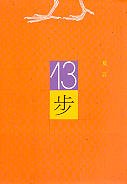Post-structuralism is a term for philosophical and literary forms of theory that both build upon and reject ideas established by structuralism, the intellectual project that preceded it. Though post-structuralists all present different critiques of structuralism, common themes among them include the rejection of the self-sufficiency of structuralism, as well as an interrogation of the binary oppositions that constitute its structures. Accordingly, post-structuralism discards the idea of interpreting media within pre-established, socially constructed structures.
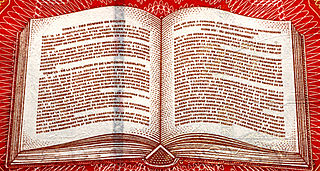
Literary criticism is the study, evaluation, and interpretation of literature. Modern literary criticism is often influenced by literary theory, which is the philosophical discussion of literature's goals and methods. Though the two activities are closely related, literary critics are not always, and have not always been, theorists.
The history of Chinese literature extends thousands of years, from the earliest recorded dynastic court archives to the mature vernacular fiction novels that arose during the Ming dynasty to entertain the masses of literate Chinese. The introduction of widespread woodblock printing during the Tang dynasty (618–907) and the invention of movable type printing by Bi Sheng (990–1051) during the Song dynasty (960–1279) rapidly spread written knowledge throughout China. In more modern times, the author Lu Xun (1881–1936) is considered an influential voice of baihua literature in China.
Jin Shengtan, former name Jin Renrui (金人瑞), also known as Jin Kui (金喟), was a Chinese editor, writer and critic, who has been called the champion of Vernacular Chinese literature.
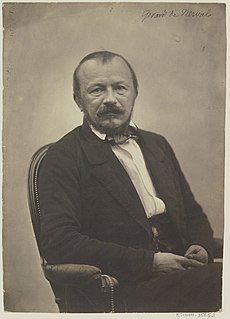
Gérard de Nerval was the pen name of the French writer, poet, and translator Gérard Labrunie, a major figure of French romanticism, best known for his novellas and poems, especially the collection Les Filles du feu, which included the novella Sylvie and the poem "El Desdichado". Through his translations, Nerval played a major role in introducing French readers to the works of German Romantic authors, including Klopstock, Schiller, Bürger and Goethe. His later work merged poetry and journalism in a fictional context and influenced Marcel Proust. His last novella, Aurélia, influenced André Breton and Surrealism.

Gao Xingjian is a Chinese émigré novelist, playwright, critic, painter, photographer, film director, and translator who in 2000 was awarded the Nobel Prize in Literature "for an oeuvre of universal validity, bitter insights and linguistic ingenuity." He is also a noted translator, screenwriter, stage director, and a celebrated painter.

The Vimalakīrti Nirdeśa is a Buddhist text which centers around a lay buddhist meditator who attained a very high degree of enlightenment considered by some second only to the Buddha's. It was extremely influential in East Asia, but most likely of considerably less importance in the Indian and Tibetan sub-traditions of Mahāyāna Buddhism. The word nirdeśa in the title means "instruction, advice", and Vimalakīrti is the name of the main protagonist of the text, and means "Taintless Fame".

Cao Yu was a Chinese playwright, often regarded as one of China's most important of the 20th century. His best-known works are Thunderstorm (1933), Sunrise (1936) and Peking Man (1940). It is largely through the efforts of Cao Yu that the modern Chinese "spoken theatre" took root in 20th century Chinese literature.

Shen Congwen, formerly romanized as Shen Ts'ung-wen, was a Chinese writer who is considered one of the greatest modern Chinese writers, on par with Lu Xun. Regional culture and identity plays a much bigger role in his writing than that of other major early modern Chinese writers. He was known for combining the vernacular style with classical Chinese writing techniques. Shen is the most important of the "native soil" writers in modern Chinese literature. Shen Congwen published many excellent compositions in his life, the most famous of which is the novella Border Town. This story is about the old ferryman and his granddaughter Cuicui's love story. Shen Congwen and his wife Zhang Zhaohe were married in 1933, Shen Congwen and Zhang Zhaohe had two sons after their marriage.
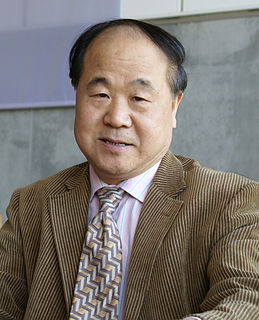
Guan Moye, better known by the pen name Mo Yan, is a Chinese novelist and short story writer. Donald Morrison of U.S. news magazine TIME referred to him as "one of the most famous, oft-banned and widely pirated of all Chinese writers", and Jim Leach called him the Chinese answer to Franz Kafka or Joseph Heller. In 2012, Mo was awarded the Nobel Prize in Literature for his work as a writer "who with hallucinatory realism merges folk tales, history and the contemporary".
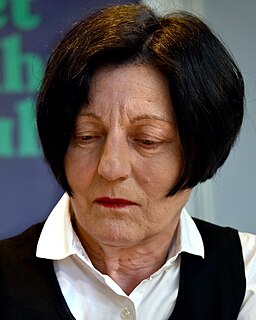
Herta Müller is a Romanian-born German novelist, poet, essayist and recipient of the 2009 Nobel Prize in Literature. Born in Nițchidorf, Timiș County in Romania, her native language is German. Since the early 1990s, she has been internationally established, and her works have been translated into more than twenty languages.
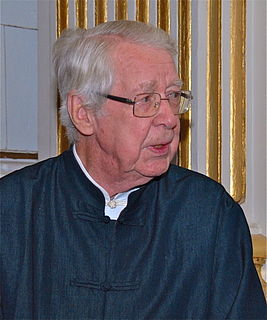
Nils Göran David Malmqvist was a Swedish linguist, literary historian, sinologist and translator. He was also a member of the Swedish Academy between 1985 and 2019.
The Romantic hero is a literary archetype referring to a character that rejects established norms and conventions, has been rejected by society, and has themselves at the center of their own existence. The Romantic hero is often the protagonist in a literary work, and the primary focus is on the character's thoughts rather than their actions.

Howard Goldblatt is a literary translator of numerous works of contemporary Chinese fiction, including The Taste of Apples by Huang Chunming and The Execution of Mayor Yin by Chen Ruoxi. Goldblatt also translated works of Chinese novelist and 2012 Nobel Prize in Literature winner Mo Yan, including six of Mo Yan's novels and collections of stories. He was a Research Professor of Chinese at the University of Notre Dame from 2002 to 2011.

The Mencius is a collection of conversations, anecdotes, and series of genuine and imagined interviews by the Confucian philosopher, Mencius. The book is one of the Chinese Thirteen Classics, and explores Mencius' views on the topics of moral and political philosophy, often as a dialogue with the ideas presented by Confucianism. The interviews and conversations are depicted as being either between Mencius and the various rulers of the Warring States period, or with his students and other contemporaries. The book documents Mencius' travel across the states, and his philosophical conversations and debates with those he meets on his journey. A number of scholars suggest that the text was not written by Mencius himself, but rather by his disciples. The text is believed to have been written during the late 4th century BC.
Hallucinatory realism is a term that has been used with various definitions since at least the 1970s by critics in describing works of art. In some occurrences the term has had connections to the concept of magical realism, although hallucinatory realism is usually more specific to a dream-state. The term occurs in the motivation for Mo Yan's Nobel Prize in Literature.

Barbara Foley, Distinguished Professor of English at Rutgers University-Newark, focuses her research and teaching on U.S. literary radicalism, African American literature, and Marxist criticism. The author of six books and over seventy scholarly articles, review essays, and book chapters, she has published on literary theory, academic politics, US proletarian literature, the Harlem Renaissance, and the writers Ralph Ellison and Jean Toomer. Throughout her career, her work has emphasized the centrality of antiracism and Marxist class analysis to both literary study and social movements.
Bernard Faure is a Franco-American author and scholar of Asian religions, who focuses on Chan/Zen and Japanese esoteric Buddhism. His work draws on cultural theory, anthropology, and gender studies. He is currently a Kao Professor of Japanese Religion at Columbia University and an Emeritus Professor of Religious Studies at Stanford University. He also previously taught at Cornell University, and has been a visiting a professor at the University of Tokyo, the University of Sydney, and the École Pratique des Hautes Études in Paris. He co-founded the Center for Buddhist Studies at Stanford University and the ARC: Asian Religions and Cultures Series within Stanford University Press. He is also the founder and co-director of the Columbia Center for Buddhism and East Asian Religions (C-BEAR). His work has been translated into several Asian and European languages.
Gloria Feman Orenstein is a feminist art critic, pioneer in the field of the women of Surrealism and scholar of ecofeminism in the arts. Orenstein's Reweaving the World is considered a seminal ecofeminist text which has had "a crucial role in the development of U.S. ecofeminism as a political position".
Misogyny, Cultural Nihilism & Oppositional Politics: Contemporary Chinese Experimental Fiction is a non-fiction book by Lu Tonglin, published in 1995 by Stanford University Press.
